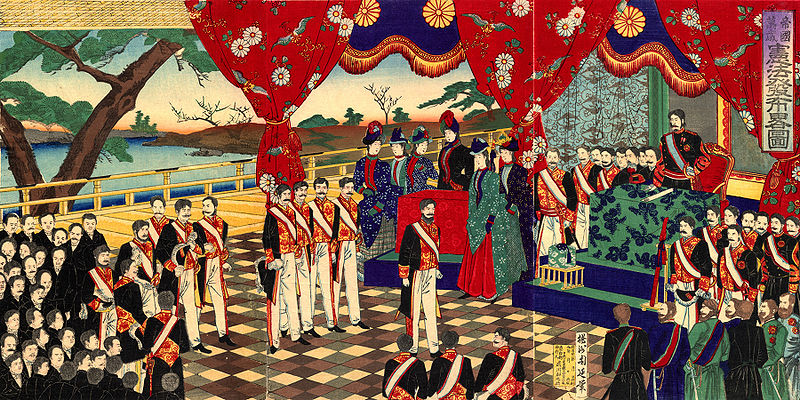This week on the Revised Introduction to Japanese History: the politics of the Meiji Period! After a coalition of samurai, nobles, loyalists, and others succeed in overthrowing the Tokugawa shogunate, they must ask themselves: what comes next? And, in the time honored tradition of revolution, they answer that question by killing off or removing from office anyone they disagree with.
Sources
Jansen, Marius. The Making of Modern Japan
Jansen, Marius. Emperor of Japan: Meiji and His World
Pyle, Kenneth. Japan Rising: The Resurgence of Japanese Power and Prestige
Sims, Robert. Japanese Political History Since the Meiji Renovation: 1868-2000
Beasley, W.G. “Meiji Political Institutions” and Vlastos, Steven. “Opposition Movements in Early Meiji, 1868-1885” in The Cambridge History of Japan, Vol V: The Nineteenth Century
Images
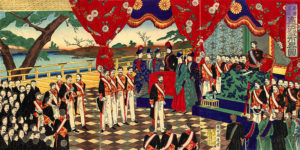
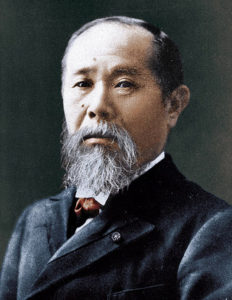
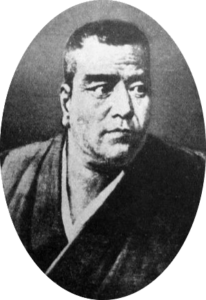
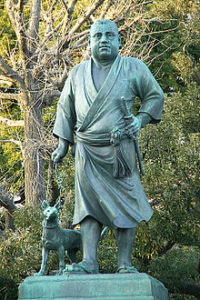
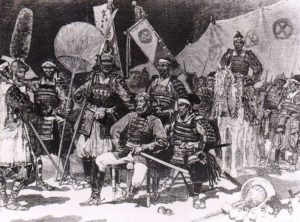
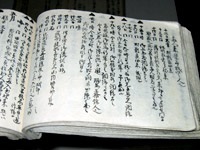
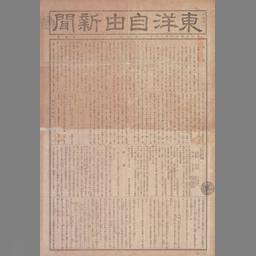
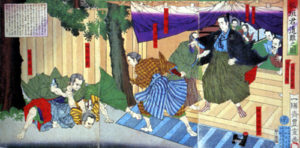
Transcript
My plan for today is to talk about the era of Japanese history that comes after the fall of feudalism, which we call the Meiji Era–named, of course, for the emperor who presided over the construction of this new, post-Tokugawa order.
And this is a REALLY hard thing to do, frankly, because the Meiji Era is one of those moments that looms really large in the narrative of Japan’s history.
Even a superficial overview presents a truly incredible story: in the 44 years between the defeat of the shogunate in 1868 and the death of the Meiji Emperor in 1912, Japan was transformed from a feudal, pre-industrial, agricultural society into an increasingly industrialized and centralized power that was a major player in international politics.
That telling of the Meiji period, of course, skips over a lot–but it’s also not wrong, and the idea of that much change in that short a span of time is, frankly, wild.
So today, I’m going to do the best I can to walk you through the political reforms of the Meiji era; next week is going to be about economic and social change.
There’s simply no way to be comprehensive here.
So, with that said, let’s start with politics, and really, this should be straightforward. The changes of 1868 have retroactively been dubbed an isshin, or restoration–and the Meiji Restoration, as it’s called, was about restoring the political power of Japan’s emperors.
But the reality was not quite so straightforward. Ostensibly, this new order did offer the emperor a lot of power, but practically the Meiji Emperor himself was not a decision-maker day to day.
Practically, power in 1868 lay with the fragile coalition that had overthrown the shogunate–a mixture of lower samurai loyalists, members of the court nobility anxious to reclaim their ancient prerogatives, and those daimyo who had been convinced to jump ship.
And the thing was, this coalition was highly unstable. Its members broadly agreed that the Tokugawa shogunate had to go, but what was going to replace it? Nobody really agreed–some wanted to tear down the entire social and political order and remake Japan along the lines of Western models, while others were nationalist chauvinists whose hope was to create something akin to a theocratic Shinto state while hewing to models of political organization from before the samurai era. Some wanted feudalism itself gone; others wanted to keep parts of the class structure. Some were doctrinaire Confucians; others had increasingly been inspired by political ideas like liberalism from overseas after spending time there themselves.
For as long as the Tokugawa shogunate had existed, there was at least a unifying threat to keep this coalition going–but once it was gone, in the time-honored tradition of political revolution, the victors were forced to confront the question: now what?
And it turned out they didn’t really agree on the answer, and so the next 15-ish years of Japan’s politics were defined by a bloody and violent power struggle over who would get to decide which answer to go with.
Broadly, we can identify a few specific coalitions within the early Meiji leadership struggling for dominance during this time. One we could call “Shinto Nationalists”–mostly hardcore adherents of the nationalistic kokugaku philosophy whose main goal as a part of the restoration was to wind the clock back politically by bringing back governing structures from the classical period (a “purer time”, in their conception), and religiously by weakening the power of institutional Buddhism and strengthening Japan’s native religious traditions–which, at this time, they began to call Shinto, the “Way of the Gods.”
We don’t have to spend much time with these people because frankly they were very unsuccessful. In the political arena, they did succeed in briefly bringing back the old Heian era government structure with its ministers of the left and right and the daijo daijin and all that which we talked about months ago.
But by the mid-1870s, the influence of Western ideas about government led to a concerted effort to shift more towards a Western-style cabinet model.
The Shinto Nationalists were also defeated in their attempts to stop one of the more lasting changes of this period: the relocation of the imperial court out of Kyoto.
Their only lasting impact was in religion, and even then it was somewhat negligible. For example, one of the first decrees of the new government proclaimed “shinbutsu bunri”, or the separation of the Gods and Buddhas–in other words, outlawing the complex interrelationship between the two and mandating that Buddhist and Shinto institutions be both dogmatically and physically separated. Partially, this was intended to help give Shinto a distinct identity, and partially to punish the Buddhist establishment, which had received a great deal of patronage from the old Tokugawa shogunate. Indeed, the government also tacitly endorsed a program of haibutsu kishaku (abolition of the Buddhas and destruction of Shakyamuni), essentially a state-backed seizure of temple lands and treasures.
These attempts, however, did not succeed at wiping out the influence of Buddhism in Japan, which was deeply entrenched after well over a millennium. Nor did similar attempts to exert authority over the nation’s Shinto shrines prove particularly effective; Shrines had centuries of independent tradition and resisted attempts at government oversight, as did the two independent aristocratic families which had overseen licensing and ranking of shrines for centuries (the Shirakawa and Yoshida families).
Similarly, attempts to mandate that all Japanese subjects be parishoners of their local shrine (as well as of Ise Grand Shrine, home to Amaterasu, the ancestor of the imperial family) proved difficult to implement and were eventually quietly dropped. By 1872, the branch of the Meiji bureaucracy responsible for religious affairs, the Jingikan, was quietly demoted and folded into the Education Ministry. The most lasting legacy of the Jingikan was the establishment and support of several nationally ranked shrines, including the creation of Yasukuni Shrine in Tokyo to house the souls of Japan’s war dead.
For the next several decades, attempts to make Shinto a central part of national identity faltered, particularly (though not exclusively) as widespread interest in foreign ideas led to a reaction against what were seen as backward Japanese notions. It was not really until 1905, when victory against Russia in the Russo-Japanese War led to a patriotic upwelling, that a renewed push to make Shinto a central part of Japan’s national identity emerged from the government and nationalistic politicians, complete with practices intended to deify war heroes or other figures who had become a part of patriotic and nationalistic narratives.
As for these shinto extremists themselves, most were quietly forced out of power early in the Meiji Period; for example, one of the most prominent among them was the kokugaku scholar Hirata Kanetane, who had been an early backer of anti-Tokugawa activism and was briefly rewarded with a government post. However, by 1872 he got into a pitched political battle for control of parts of the religious bureaucracy, lost it, and was quietly demoted and then removed from office. Most of his followers and supporters followed shortly thereafter.
These Shinto Nationalists were the first to get winnowed out of the victorious Meiji coalition, but not the last–and they were probably the least dangerous, because most of their adherents were members of the old courtly aristocracy, religious leaders, and the like–in other words, they weren’t fighters.
One of the far deeper splits within the victorious coalition ran right down the middle of its samurai supporters–on the question of Westernization.
You see, over the course of the 1860s, it had become obvious that Japan would have to embrace some modern technology in order to survive–anyone who had doubts about this was likely cured of those doubts (or cured of being alive) by the bloody failures of the various attempts to “expel the foreigners”.
But what did making use of Western technology mean specifically? Was it possible to combine industrialization and military modernization with the existing social order? That was the contention of some, inspired by the reforms of China’s Qing dynasty after the Opium Wars, which were spearheaded under the slogan “Eastern Ethics, Western Science”–that a new order, using Western industrial technology but maintaining the existing political and social order, would become stronger by incorporating the best elements of both.
Others, however, were far more pessimistic. In particular, members of the victorious Meiji Coalition who had spent time overseas tended to be more invested in a wholesale tearing down of the existing order–many were of the opinion that it wasn’t just Western science and technology that was superior, but political and social organization.
It is worth noting that part of the reason they believed this was the rhetoric of the Western imperial powers themselves, which justified the imposition of unequal treaties on Japan and other nations in Asia by saying those places were “uncivilized” and “backward”–which was why, for example, foreign nationals living in those areas needed immunity from “barbaric” Japanese law.
Thus, for example, Inoue Kaoru and Ito Hirobumi–two Choshu domain loyalists who spent some time overseas in the 1860s–were very much of the “tear it all down” camp, while Saigo Takamori of Satsuma domain (one of the most renowned commanders of one of the most powerful feudal domains behind the new order) was not.
For the first few years, this division wasn’t too toxic; after all, regardless of your side, you probably agreed that some reform and centralization was necessary, and at any rate it had precedent in both the more centralized administration of powers like France and the UK and in the traditions of pre-feudal governance in Japan.
Thus, for example, reforms like the creation of a national military from forces of pro-restoration domains, or the abolition of the feudal domains themselves and their replacement with a system of prefectures run by governors, was not particularly controversial–after all, this was how it had worked 1000 years ago too.
What WAS rather controversial was an increasing push to do away with feudal privileges among the more ardent Westernizers, including the abolition of the samurai class itself.
This might seem strange on its face, because many of these ardent Westernizers were also samurai themselves; why would they want to abolish their own social class?
The answer was that many–like, for example, Ito Hirobumi and Inoue Kaoru–were lower samurai, and thus had never been particularly attached to the feudal social order. After all, for them it had mostly meant restrictions on their ability to rise due to the privileges of higher-ranking members of their own class.
Many of these lower samurai were also concerned that the status system and its tendency to prescribe people’s social role based on inherited status would weaken Japan, because this prevented the most able and adept from rising to the top based on their merits. This notion of merit, of society and the social order as a competition that was won by the best, was very influenced by 19th century social Darwinism and would have a powerful influence on life in the imperial period.
Finally, many members of the Meiji leadership became convinced of the importance of revising the social system because of their own experiences overseas–which a LOT of them did have thanks to something called the Iwakura Mission, launched in 1872. Ostensibly, the goal of this mission were straightforward; the 1858 Treaty of Amity and Commerce between Japan and the United States, which served as a model for many of the other unequal treaties that had been forced on Japan, contained a provision allowing either party to renegotiate terms starting after July 4, 1872. The goal of the mission was to start these renegotiations, and to establish the legitimacy of the new government with its first massive overseas diplomatic effort.
The face of the mission and its namesake was Iwakura Tomomi, a member of Japan’s courtly aristocracy that had once made up the imperial court in Kyoto. Iwakura’s star had risen during the chaos of the foreign crisis–he’d become an influential advisor to the throne, arguing that the foreign crisis was a chance for the court to claw back more of its old political power. However, he drew the ire of both imperial loyalist extremists (who saw his willingness to negotiate with the shogunate as unacceptable) and the shogunate itself (which viewed him as an agitator), and had to spend much of the 1860s in exile from Kyoto escaping both assassins and the law. When the shogunate fell, however, his history served him well; he had established a reputation as a clear-eyed political thinker and a patriot, and rapidly rose through the ranks of the new government as a result. This–plus the fact that, at 46, he was one of the oldest and most respected members of the new government–made him a natural choice to helm the mission.
However, even with Iwakura’s leadership, the diplomatic side of the mission was frankly an unmitigated disaster. Iwakura and his allies made their way west across the Pacific to California, and from there overland to Washington, DC, only to be told that they didn’t actually have official credentials from their own government proving that they had authority to negotiate on the treaty issue with American diplomats. Two members of the mission–the young statesmen Okubo Toshimichi and Ito Hirobumi, both of whom would become extremely influential in their own rights in the future–thus had to trek all the way back to Tokyo to get those credentials When the negotiations finally did commence, Iwakura found himself largely stonewalled by the Americans, who were not willing to give up their treaties if other Western powers would not agree to as well. Iwakura quickly abandoned all negotiations, saying instead that he would pursue an international conference in the future to end the treaties. He would never get his chance; he died in 1885, and the mission itself was initially lambasted in the Japanese press as a failure.
However, the diplomatic side of the mission is not really what the Iwakura Mission is remembered for. After the failure of the US negotiations, Iwakura and the mission leadership decided there was nothing for it but to continue onward–not to try and negotiate, but to at least make a diplomatic gesture towards the other Western powers. As a result, the mission wound its way through Europe, stopping in the UK, France, Italy, Germany, Denmark, Sweden, Austria, the Netherlands, and Switzerland before heading back through the newly constructed Suez Canal towards Japan (stopping along the way at French and British colonial outposts like Singapore and Saigon). All along the way, the mission members were wined and dined by polite society. Thus, while the unequal treaties remained on the books, the new government–and its commitment to at least a degree of Westernization–gained a great deal of popular publicity in Europe and the United States.
And many of the members of the mission came back to Japan convinced that Westernization was more urgent than ever, having seen the wealth and power of Western empire up close.
Indeed, it’s not an accident that many of the figures who would lead the charge to abolish the samurai (and other legal status distinctions) in later years were former Iwakura Mission participants (Okubo Toshimichi in particular). By contrast, Saigo Takamori, one of the most entrenched opponents of the idea, had remained behind during the mission.
Beyond this, there were a few other reasons why leaders began to support the abolition of feudalism. Perhaps the biggest was simply financial. The samurai class was not massive(estimates vary substantially, but the most commonly cited number is between 8-10% of the national population representing almost 400,000 different families), but even so paying their stipends was a major drain first on the finances of feudal domains and then, after the domains were abolished in 1871, on the national treasury–by some estimates, as much as 30% of the annual budget.
There was also, of course, the constant worry of any new or unstable government–revolt and revolution. The samurai represented an armed force with a great deal of personal independence–and conservative members of the class could and did rise up against government edicts they disagreed with, either by all out rebellion or by assassinating leaders they disliked. For an oligarchic leadership increasingly committed to Westernization–viewed by the leadership as the primary driver of increased national power and prestige, the end-goal of the whole Meiji state–the samurai looked more and more like a roadblock than anything else.
And so the edicts began to reign down. There was no single edict that you could point to saying that the samurai were no more–instead, a host of separate laws in the early and mid-1870s stripped away their hereditary privileges. The wearing of swords in public was first made optional in 1871 and then banned in 1876. Also in 1871, the government issued an edict discouraging the wearing of the chonmage, the traditional samurai topknot, in favor of “modern” hairstyles; having one was not made illegal, but it was discouraged, and practically speaking if you wanted a government job or a position of any prestige you had to cut your hair. 1876 also saw the chitsuroku shobun, the law abolishing samurai stipends in favor of one-time cash payments–essentially, a severance payment for samurai families.
As one might imagine, poverty and the loss of privileged social status generated a great deal of hostile feeling against a government that was viewed as having unjustly stripped warriors of their positions. Former samurai began to organize–some formed the nation’s earliest political parties, hoping to push back against what they saw as an overbearing and unaccountable government. However, others began to organize for conflict and arm themselves.
Starting in February of 1874, this anti-government feeling erupted into a series of rebellions in Hizen, Choshu, and Akizuki domains by former samurai. It is worth noting that despite the conservative demands of the rebels, they were not opposed to the use of Western weaponry or to limited Westernizing reforms–it was instead the fullscale upending of the traditional social order that was seen as a threat to the social identity of samurai, and the cultural identity of Japan itself. The rebels made use of Western style weaponry, for example–though often they lacked a logistical infrastructure to supply ammunition and were forced to resort to more traditional methods when the bullets ran out.
The largest of these rebellions took place in Satsuma, in 1877–led by none other than Saigo Takamori himself, who previously had been a major figure in the Restoration government but who was forced out of office due to his views (both on social modernization and on other issues we don’t have room to discuss here).
None of these rebellions was successful, however; all were put down by the nascent Imperial Japanese Army, which over the course of the 1870s was transformed into a modern conscript army pulling from all social stations–proof, in a certain sense, of the pointlessness of the old status distinctions.
Saigo and his fellow rebel samurai would die fighting the new government. His image specifically would eventually be rehabilitated given his popularity as one of the great heroes of the war against the shogunate. Saigo was transformed in government propaganda into a brave if somewhat misguided patriot after the first few decades of the Meiji Era, when samurai dissent became less of an issue.
More broadly, conservative pushback against Westernization did continue–Okubo Toshimichi, an old political ally of Saigo’s who helped orchestrate the campaign that led to his death, was assassinated the next year by a disgruntled samurai. Mori Arinori, an ardent Westernizer and education minister, was cut down in 1889 on his way to hear the emperor announce Japan’s new constitution. However, Saigo’s rebellion was the last serious samurai pushback against a government increasingly devoted to casting aside what it saw as outmoded social and political institutions.
So, once again, the Meiji coalition was winnowed down; by the dawn of the 1880s, the only ones left were committed Westernizers who were invested in remaking Japan.
But remaking it into what? Once again, we have a thorny question, and divergent answers. The split that emerged by the mid to late 1870s was one around not whether or not to model the new Japan’s politics off those of the West–everyone agreed on that–but on which model to use.
On the one hand were a number of members of the surviving leadership–composed by now of an ever shrinking number of former samurai who had been leaders within Satsuma and Choshu domains, and to a lesser extent their early supporters in the war against the shogunate like Tosa and Hizen domains–who were inspired by liberalism.
Okuma Shigenobu, from Hizen domain, was a committed Anglophile who thought that British-style constitutional monarchy was the path to follow–after all, look how it had worked out for the British by the late 1800s.
Others, like the Tosa-based Itagaki Taisuke, looked instead to France, and to the model of Republicanism that it espoused–though Itagaki was quick to note that unlike the French, he had no desire to do away with monarchy as a concept, merely to institute a regime focused on defending individual liberties.
Arrayed against them were more conservative politicians, chiefly from Choshu and Satsuma–particularly Choshu. This group admired a far more authoritarian approach to politics, one exemplified by the nascent German Empire–where the kaiser had made limited concessions to demands for representation and voting rights with an elected Reichstag, or parliament, but where power remained overwhelmingly centralized in the hands of the monarch and his government.
Once again, we have a split in the ruling coalition, and once again that split would crystalize into a dispute that would see that coalition go to war with itself. This time, the crystalizing issue was not feudalism, but a constitution.
For Western imperial powers, one of the justifications for imposing unequal treaties on Japan was the idea that Japanese political systems were insufficiently developed–with the lack of a clear governing constitution being one of the markers of this inferiority. This notion was, of course, rooted in prejudice and not accurate in any case–there was a clear governing structure that could be called a constitution under the shogunate, it was simply not formalized in the same way as was done in Europe and the Americas. And hey, the British don’t have a formal constitution either, and also they drink warm beer, but nobody calls them uncivilized.
Still, the idea that Japan should have a constitution became bound up in the drive among Japanese leaders to undo the unequal treaties and be seen as the equal of the Western powers–and so from the start of the Meiji period, the leadership of the new imperial government accepted as a matter of course that Japan would need a constitution.
That idea was even baked into the Charter Oath, the declaration of principles of the new regime issued in the emperor’s name in April, 1868. Article 1 of the oath stated that, “Deliberative assemblies shall be widely established and all matters decided by public discussion,” while articles 4 and 5 declared an end to “evil customs of the past” and a return to the “just laws of nature”, and that “Knowledge shall be sought throughout the world so as to strengthen the foundations of imperial rule.” Presumably, this included knowledge of good government–including a modern constitution.
But what form would that constitution take, and what would “deliberative assemblies”–or for that matter the business of politics in general–look like under the new regime?
That sort of question was tailor-made to drive a wedge between the liberal and autocratic blocks of the governing coalition–which, by the way, you will note wasn’t just ideological. Much academic hay has been made of the fact that those divisions also replicated geographic splits within the coalition; leaders from the stronger domains of Satsuma and Choshu which had really spearheaded the victory against the shogunate were overwhelmingly on the side of autocratic government. By comparison, Tosa and Hizen were the source of most of the liberals in the governing coalition.
I say this not to imply that the ideological divide wasn’t genuine–it very much was–but it was not the only divide that existed. There was also a competition between the old domains themselves.
And that was a competition that the autocratic Choshu and Satsuma factions would win pretty handily. The liberals in the governing coalition were slowly forced out; Itagaki Taisuke of Tosa had gotten bounced from government back in 1873 both for his backing of a more aggressive foreign policy against Korea and because of his fullthroated opposition to dominance of the new government by Satsuma and Choshu.
Okuma Shigenobu, meanwhile, was politically outmaneuvered in 1881 by Ito Hirobumi himself. Ito publicized several political scandals involving Okuma (accusing him of involvement in some corrupt dealings up in Hokkaido, where the government office responsible for managing the island had been caught making favorable deals selling off some of its assets in exchange for bribes). He also critized Okuma for publicly supporting the idea of Japan taking on loans to fund continued economic and military modernization, essentially accusing him of lacking patriotism.
In fact, Ito was going after Okuma because the latter had submitted a petition to the emperor for a more liberal constitution, and there wasn’t really any proof Okuma had been involved in the corrupt dealings in Hokkaido (in fact, the official who WAS most directly involved, Kuroda Kiyotaka, was a political enemy of his).
Still, that’s politics for you; reality mattered less than perception, and Okuma, worried his reputation would be destroyed, agreed to resign with a face-saving excuse about health issues (which would become a time-honored excuse for politicians to leave office because of a scandal without directly acknowledging the scandal itself).
Ito and his more autocratic supporters were thus able to push their opponents out of office and secure control of the government itself–a control they would maintain into the 20th century itself. Still, the liberals didn’t role over; Itagaki and Okuma responded by organizing some of Japan’s first political parties.
the Jiyuto (or Liberal Party) for Itagaki and the Kaishinto, or Reform party, for Okuma. These parties rallied against the government, pushing for greater popular representation–in some cases, things even devolved into violent confrontation with the forces of the state. Itagaki in particular was stabbed in the chest in the city of Gifu during a rally in April 1882 by a pro-government conservative. Supposedly, as the knife struck home, Itagaki cried out, “Itagaki may die, but liberty never!”–though personally, I’ve always had my doubts how real that story, which appears mostly in newspaper accounts of the stabbing, is.
I’ve never been stabbed, but I assume I would shout something more like OH GOD I’VE BEEN STABBED.
Still, it doesn’t matter either way; Itagaki survived the wound and continued to campaign.
Yet neither Itagaki nor Okuma, nor the wider movement they were associated with–the Freedom and People’s Rights Movement–was terribly successful in altering government policy, particularly around a new constitution.
Instead, Ito Hirobumi and his fellow councilors would take the lead in drafting the constitution, and the result very much reflected that reality. The final draft of a new constitution–put together by Ito in consultation with German lawyers and constitutional experts–would become the one promulgated in 1889 and which went into effect in 1890. The Meiji Constitution, as it is known, largely reflected the German model. The Emperor retained a great deal of power; the preamble, delivered in the emperor’s voice, even explicitly stated that the emperor had inherited sovereignty over the state and would always wield it, albeit within the limits of the constitution. Practically speaking, of course, the emperor did not govern directly–in accordance with longstanding political tradition, he largely remained a figurehead, so as to avoid sullying his own image by either participating too directly in politics or making any foolish choices that would undercut his legitimacy. Instead, any mistake could be blamed on bad advisors, who could take the heat to protect the throne. This proved to be a major structural weakness of the system–the constitution did not make clear who would actually wield power if the emperor did not, and scrambling for informal influence and control over the throne became a major hallmark of imperial politics.
Some concessions to popular representation and liberalism were included in the text; it made allowances for a National Diet, or parliament (the word Diet originating from German), which would have an elected lower house. The upper house, however, would be comprised either of imperial appointees handpicked by the emperor and his advisors or by the heirs to the old Kyoto kuge aristocracy and the daimyo feudal lords, who had received titles of nobility in exchange for giving up their old privileges that came with hereditary seats in parliament. Even so, the lower house could be quite powerful–in particular, its approval was required for any new budget to pass. Both Okuma and Itagaki organized parties to contest new national elections (at first limited to male members of the middle class paying a certain amount of taxes, though the franchise was expanded over time) and were highly successful at the ballot box.
This in turn enabled those parties to push back against Ito and his authoritarian clique, primarily by threatening not to pass budgets using their popularity in the House of Representatives.
Theoretically, there was a safeguard against this; the constitution specified that if no budget was passed, the one from the previous year would carry over. But this wasn’t as effective as Ito had hoped: in a period where government expenditure was constantly growing to facilitate military expansion and economic development, the budget had to grow constantly too.
Ito himself would eventually be forced to try to organize his own political party, the Rikken Seiyukai (Constitutional Friends of Government Party) to fight back against his liberal opposition, but that opposition would continue to mount during the final decades of the Meiji Emperor’s reign–even culminating in riots in Tokyo against government policy.
Eventually, these protests would be successful in forcing a degree of political change–the liberals would, for a time, get some wind under their sails.
But that’s a story for the future–and we’ve got some other aspects of the Meiji era to go over before we get there.
